Discover 35 hidden attractions, cool sights, and unusual things to do in Alexandria (United States). Don't miss out on these must-see attractions: Mount Vernon Trail, George Washington Masonic National Memorial, and Torpedo Factory Art Center. Also, be sure to include Woodrow Wilson Bridge in your itinerary.
Below, you can find the list of the most amazing places you should visit in Alexandria (Virginia).
Table of Contents
Mount Vernon Trail
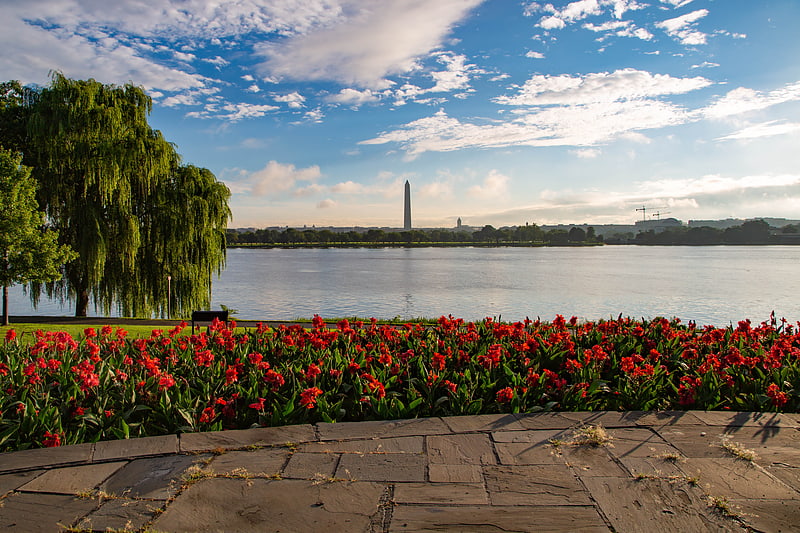
The Mount Vernon Trail is a 17-mile long shared use path that travels along the George Washington Memorial Parkway in Northern Virginia between Rosslyn and George Washington's home at Mount Vernon. The trail connects the easternmost portions of Arlington County, the City of Alexandria, and Fairfax County, and travels mostly on dedicated trail with a small portion on city streets. As part of U.S. Bike Route 1, the Potomac Heritage Trail and the East Coast Greenway, the MVT opened in April 1972 as a gravel path and was subsequently expanded and paved.
The MVT is part of the much larger mid-Atlantic Potomac Heritage National Scenic Trail.[1]
Address: Along Shoreline, Alexandria
George Washington Masonic National Memorial
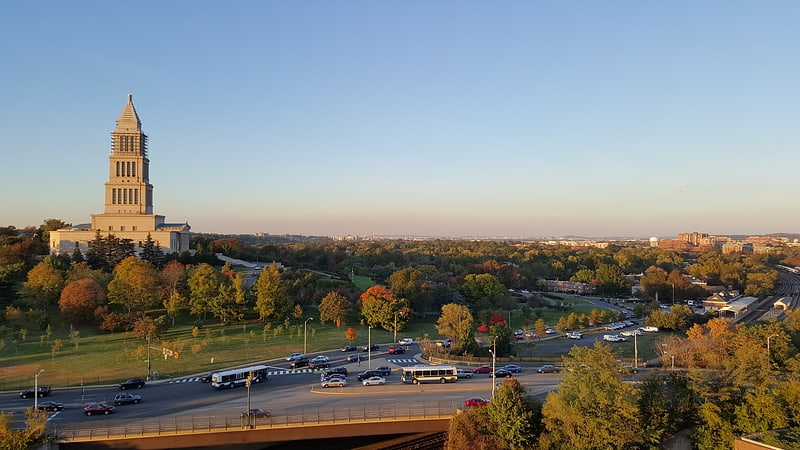
Building in Alexandria, Virginia. The George Washington Masonic National Memorial is a Masonic building and memorial located in Alexandria, Virginia, outside Washington, D.C. It is dedicated to the memory of George Washington, the first President of the United States and a Mason. The tower is fashioned after the ancient Lighthouse of Alexandria in Egypt. The 333-foot tall memorial sits atop Shooter's Hill at 101 Callahan Drive. Construction began in 1922, the building was dedicated in 1932, and the interior finally completed in 1970. In July 2015, it was designated a National Historic Landmark for its architecture, and as one of the largest-scale private memorials to honor Washington.
The memorial is served by the King Street–Old Town Metro station on the Blue and Yellow Lines of the Washington Metro. The station is located about four blocks from the memorial.[2]
Address: 101 Callahan Dr, 22301-2751 Alexandria (Alexandria)
Torpedo Factory Art Center
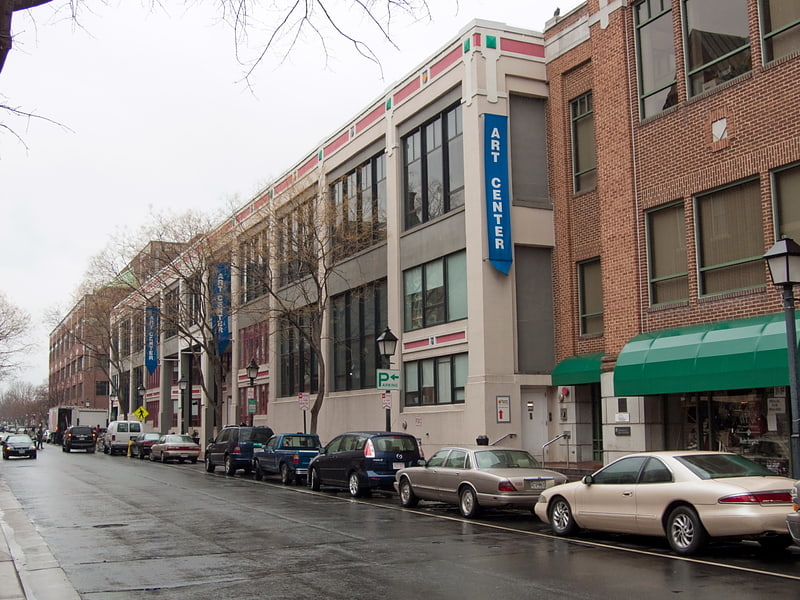
Art center in Alexandria, Virginia. The Torpedo Factory Art Center is the former U.S. Naval Torpedo Station, a naval munitions factory on the banks of the Potomac River in Old Town, Alexandria, Virginia which was converted into an art center in 1974. The facility is located at 105 N. Union Street, near the eastern end of King Street.
The Torpedo Factory Art Center is home to the largest number of publicly accessible working artist studios in the U.S. Each year, more than a half-million visitors interact with its community of artists. As of March 2022, it housed 82 artists' studios, 8 galleries, and workshops, with some 165 professional visual artists who work in a variety of media, including painting, ceramics, photography, jewelry, stained glass, fiber, printmaking, and sculpture. The Torpedo Factory has become a model of creative placemaking for other communities.
Artists are selected as part of an annual jury and re-jury process. Once accepted, they receive a three-year lease of publicly subsidized rent.[3]
Address: 105 N Union St, 22314 Alexandria (Alexandria)
Woodrow Wilson Bridge
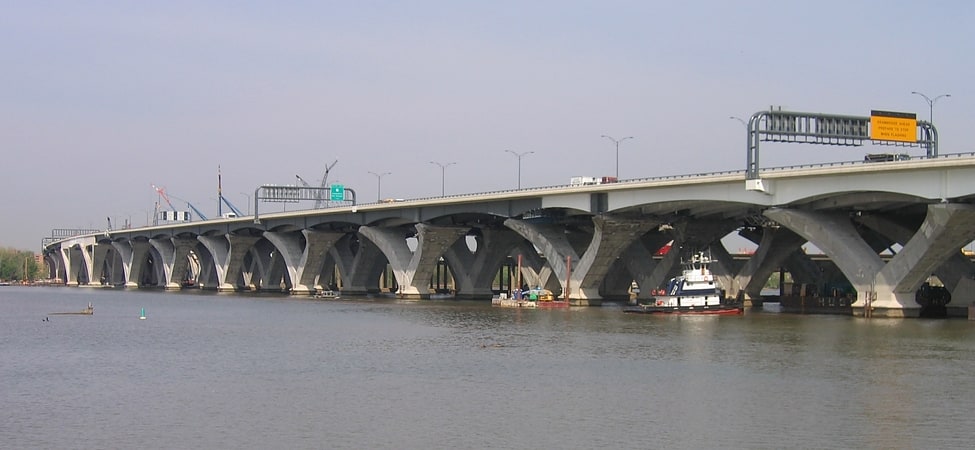
Bascule bridge in Prince George's County, Maryland. The Woodrow Wilson Memorial Bridge is a bascule bridge that spans the Potomac River between the independent city of Alexandria, Virginia, and Oxon Hill in Prince George's County, Maryland, United States. The original bridge was one of only a handful of drawbridges in the U.S. Interstate Highway System. It contained the only portion of the Interstate system owned and operated by the federal government until construction was completed and it was turned over to the Virginia and Maryland departments of transportation.
The Wilson Bridge carries Interstate 95 (I-95) and I-495 (the Capital Beltway). The drawbridge on the original span opened about 260 times a year, frequently disrupting traffic on a bridge that carried about 250,000 cars each day. The new, higher span requires fewer openings.
The bridge's west abutment is in Virginia, a small portion is in Washington, D.C., and the remaining majority of it is within Maryland (because that section of the Potomac River is within Maryland's borders). About 300 feet (91 m) of the western mid-span portion of the bridge crosses the tip of the southernmost corner of the District of Columbia. It is the only bridge in the United States that crosses the borders of three state-level jurisdictions (DC, Maryland, and Virginia). The section in Washington, D.C. is also the shortest segment of Interstate highway between state lines.
The bridge is named for the 28th President of the United States, Woodrow Wilson (1856–1924), a native of Staunton, Virginia. While he was president, Wilson reportedly spent an average of two hours a day riding in his automobile to relax or to "loosen his mind from the problems before him." President Wilson was an advocate of automobile and highway improvements in the United States. In 1916, he said, "My interest in good roads is...to bind communities together and open their intercourse, so that it will flow with absolute freedom and facility".[4]
The Birchmere
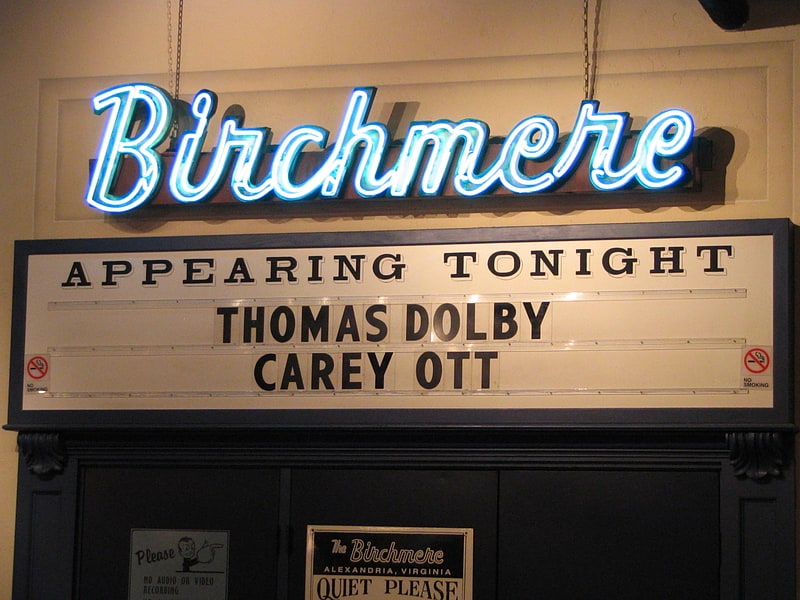
Concert hall in Alexandria, Virginia. The Birchmere is a concert hall in Alexandria, Virginia that features rock, blues, bluegrass, country, folk, jazz, ethnic, and comedic performers. Its main room seats 500 and provides dinner service, making for an intimate space, with tables only a few feet away from the stage. The location also features a bandstand with a bar and a dance floor.[5]
Address: Alexandria, 3701 Mt. Vernon Ave.
Fort Ward
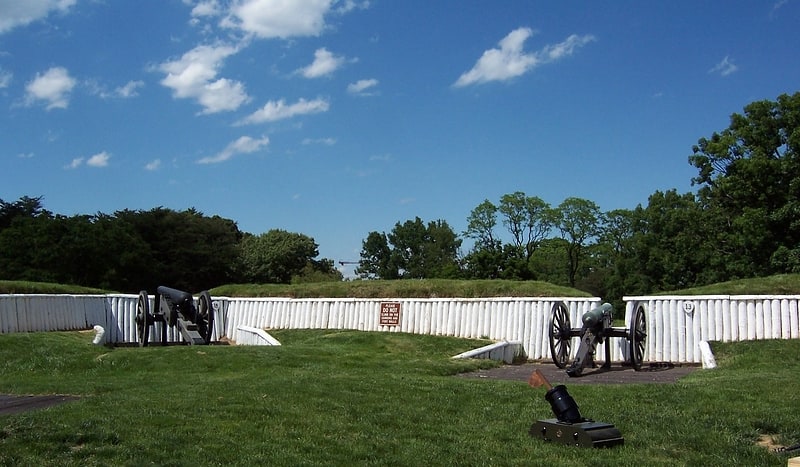
Museum in Alexandria, Virginia. Fort Ward is a former Union Army installation now located in the city of Alexandria in the U.S. state of Virginia. It was the fifth largest fort built to defend Washington, D.C. in the American Civil War. It is currently well-preserved with 90-95% of its earthen walls intact.[6]
Address: 4301 W Braddock Rd, 22304-1007 Alexandria (Alexandria)
Christ Church
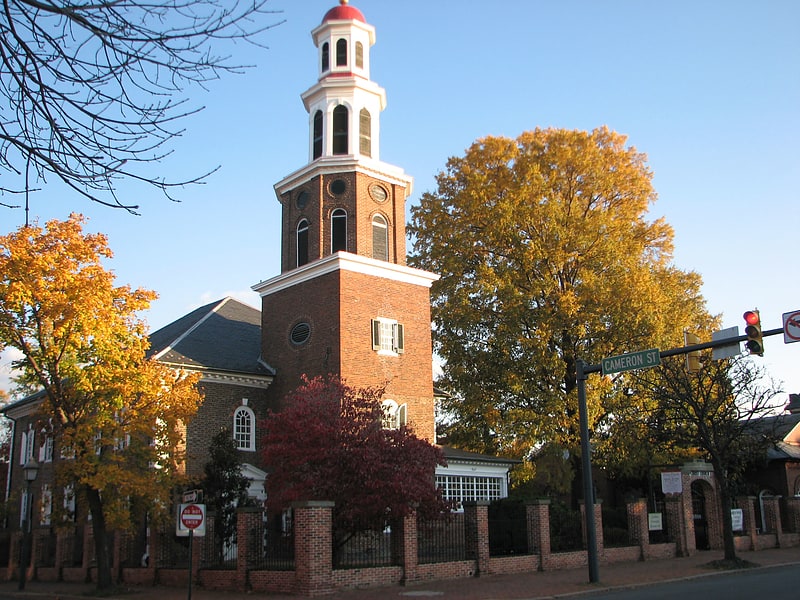
Church in Alexandria, Virginia. Christ Church is an Episcopal church located at 118 North Washington Street, with an entrance at 141 North Columbus Street, in Alexandria, Virginia. Constructed as the main church in the Church of England's Fairfax Parish, the building was designed by Col. James Wren, a descendant of Sir Christopher Wren. To finance construction of the church, the Fairfax Vestry raised 31,186 pounds of Oronoco tobacco from parishioners. Construction began in 1765, under the direction of James Parsons. After four years, the church was still unfinished. The vestry relieved Parsons of his duties as overseer of the construction. John Carlyle accepted the position and handed the keys of the completed building over to the vestry in February 1773.
Initially the pews were box pews and a two-tier pulpit was situated on the north side of the sanctuary. There was no font because until after the Civil War, weddings, baptisms, and the churching of women took place at home. In the mid-nineteenth century, stoves were put in the back of the church and the box pews were converted to the slips that are in use today. During a renovation later that century, the original pulpit was replaced by the current wine-glass pulpit. The only remaining hand-carved hymnal rack is in the Lee pew. The plaques on either side of the chancel were hand-lettered by Wren and have never been retouched. They display the Decalogue, the Lord's Prayer, the Apostles' Creed, and the Golden Rule. Wren used ink and then varnished his work just as an artist varnishes a finished painting. Over time the carbon in the ink and the alcohol in the varnish formed an acetate that created the wonderful burnished patina of the plaques. If you look closely, you can see Wren's brushstrokes and one drip.
George Washington, Henry Lee, Robert E. Lee, Charles Simms, Philip Marsteller, and Henry Fowler are a few of the church's notable parishioners (members). Until the twenty-first century, it was tradition for sitting presidents to attend a service. Franklin Roosevelt, Winston Churchill, and Eleanor Roosevelt visited the church on January 1, 1942 to commemorate World Day of Prayer for Peace. The church was known as Fairfax Church until given the name Christ Church in 1816. It was declared a National Historic Landmark in 1970.[7]
Address: 118 N Washington St, 22314 Alexandria (Alexandria)
Carlyle House
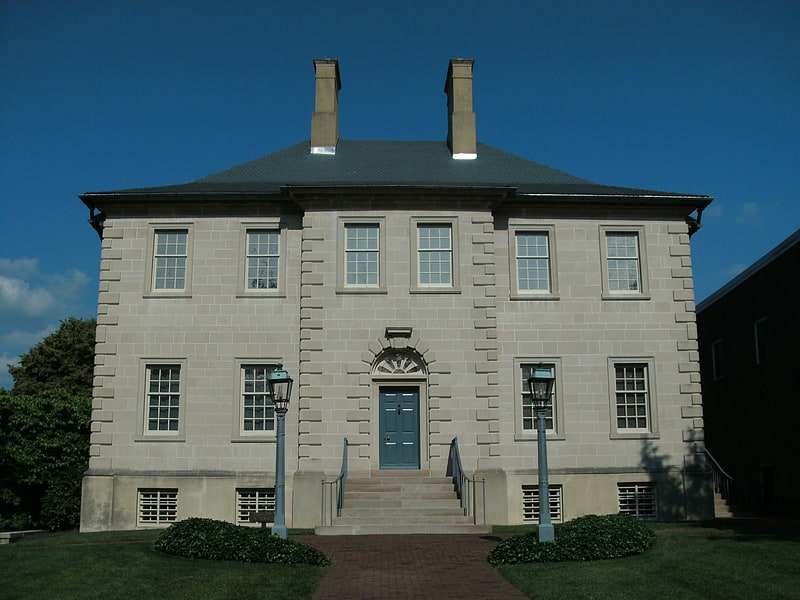
Mansion in Alexandria, Virginia. Carlyle House is a historic mansion in Alexandria, Virginia, United States, built by Scottish merchant John Carlyle in 1751 to 1752 in the Georgian style. It is situated in the city's Old Town at 121 North Fairfax Street between Cameron and King Streets. The house, which is architecturally unique as the only stone 18th-century Palladian Revival style residence in Alexandria, was added to the National Register of Historic Places in 1969, and was restored in 1976.[8]
Address: 121 N Fairfax St, 22314-3229 Alexandria (Alexandria)
Gadsby's Tavern

Museum in Alexandria, Virginia. Gadsby's Tavern is a complex of historic buildings at 134 and 138 North Royal Street at the corner of Cameron Street in the Old Town district of Alexandria, Virginia. The complex includes a c.1785 tavern, the 1792 City Tavern and Hotel, and an 1878 hotel addition. The taverns were a central part of the social, economic, political, and educational life of the city of Alexandria at the time. Currently, the complex is home to Gadsby's Tavern Restaurant, American Legion Post 24, and Gadsby's Tavern Museum, a cultural history museum. The museum houses exhibits of early American life in Virginia, and the restaurant operates in the original 1792 City Tavern dining room, serving a mixture of period and modern foods.
The complex was designated a National Historic Landmark in 1963 and was added to the National Register of Historic Places in 1966.[9]
Address: 134 N Royal St, 22314 Alexandria (Alexandria)
Alexandria City Hall

Building in Alexandria, Virginia. The Alexandria City Hall also known as the Alexandria Market House & City Hall, in Alexandria, Virginia, is a building built in 1871 and designed by Adolph Cluss. It was listed on the U.S. National Register of Historic Places in 1984. The site was originally a market from 1749 and courthouse from 1752. A new building was constructed in 1817 but after an extensive fire in 1871 it was rebuilt as a replica of the former building.[10]
Address: 301 King Street, Alexandria (Alexandria)
Farmers Market
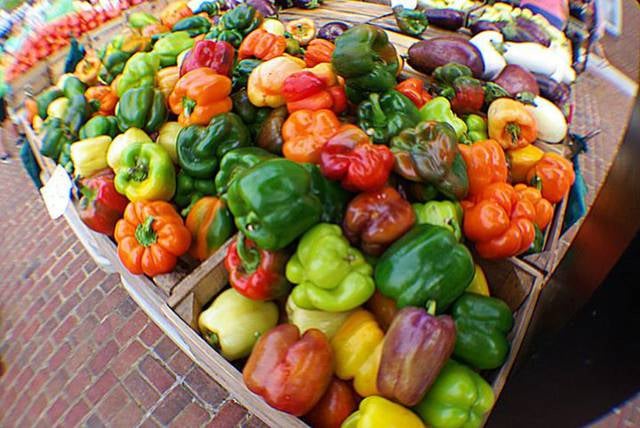
Market, Shopping, Farmer's market, Food and drink
Address: 301 King St, 22314-3211 Alexandria (Alexandria)
Jones Point Light
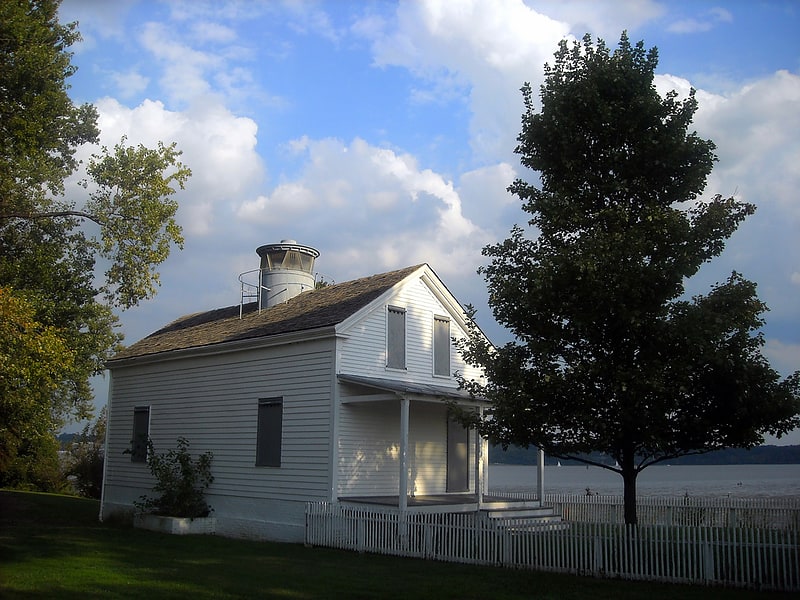
Lighthouse in Alexandria, Virginia. The Jones Point Light is a small river lighthouse located on the Potomac River in Alexandria, Virginia. It was built in 1855. It is a small, one-story house with a lantern on top and served primarily as a warning light for naval ships approaching the Washington Navy Yard. The lighthouse was discontinued in 1926, replaced by a small steel skeletal tower located nearby; this smaller tower was in use for ten years before being discontinued. After being dark for more than half a century, Jones Point Light was relit by a private concern in 1995, however, it was eventually put out again after ownership switched from the Daughters of the American Revolution Foundation to the National Park Service. Certain local efforts have called for the structure to be relit, but as of 2017, the only working lighthouse on the Potomac River is the Fort Washington Point Lighthouse, located five miles downriver.
The lighthouse is located on Jones Point in Alexandria, and is part of Jones Point Park. Visitors can approach the lighthouse, but it is currently impossible to enter the building.
The lighthouse is immediately north of the confluence of Hunting Creek and the Potomac River. The 1791-1792 survey of the boundaries of the District of Columbia began at a spot that was then at the tip of a cape at the Point. The south cornerstone from the boundary survey remains in the seawall adjacent to the lighthouse.
In 1980, the lighthouse and the cornerstone were listed in the National Register of Historic Places as reference #80000352. The lighthouse is also listed in the Library of Congress Historic American Buildings Survey as survey number VA-641. The listing shows lighthouse drawings and several black-and-white photos of the lighthouse prior to restoration.[11]
Address: Jones Point Park, Alexandria (Alexandria)
Pope–Leighey House
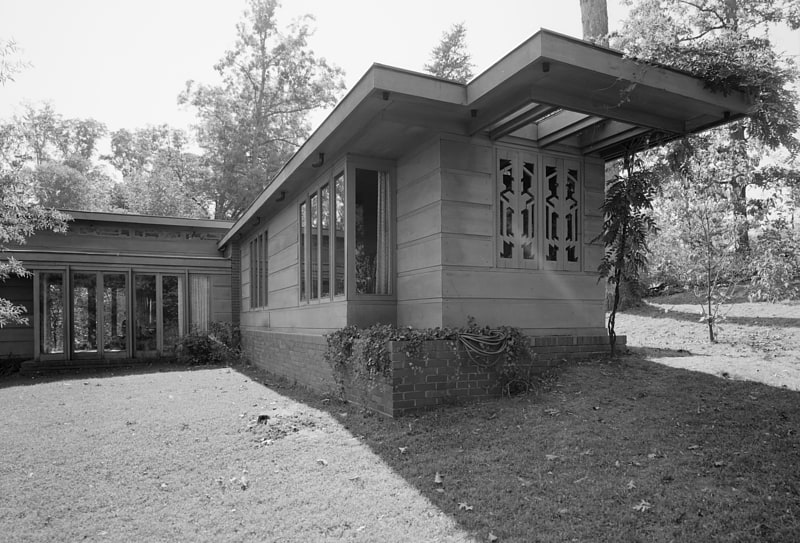
The Pope–Leighey House, formerly known as the Loren Pope Residence, is a suburban home in Virginia designed by American architect Frank Lloyd Wright. The house, which belongs to the National Trust for Historic Preservation, has been relocated twice and sits on the grounds of Woodlawn Plantation, Alexandria, Virginia. Along with the Andrew B. Cooke House and the Luis Marden House, it is one of the three homes in Virginia designed by Wright.[12]
Address: 9000 Richmond Hwy, 22309-1506 Alexandria
Lee-Fendall House

Museum in Alexandria, Virginia. The Lee–Fendall House is a historic house museum and garden located in Old Town Alexandria, Virginia at 614 Oronoco Street. Since its construction in 1785 the house has served as home to thirty-seven members of the Lee family, hundreds of convalescing Union soldiers, the prominent Downham family, the family of powerful labor leader John L. Lewis, and enslaved or free servants of those families.
The 1785 house, standing on its original half-acre lot, is in the vernacular "telescopic style" of architecture similar to many Maryland homes, but rare in northern Virginia (see below). The house was renovated in 1850, adding Greek Revival and Italianate elements to the original structure.
The historic home is listed on the National Register of Historic Places for state significance and the Virginia Landmarks Register, and is a documented contributing feature to the National Historic Landmark District of Alexandria, Virginia.
The property is now owned and operated by the Virginia Trust for Historic Preservation. It is run as the Lee-Fendall House Museum and Garden providing exhibits, tours, and special programs to:
- Preserve its architectural and historic value
- Bring to light the key business, political, military, and labor roles played by its enslaved or free people
- Spread knowledge and appreciation for Alexandrian, Virginian, and American history.
The Lee–Fendall House Museum and Garden is usually open for tours on the hour Wed.-Sat. 10-3, and Sun. 1-3. Call (703) 548-1789 to confirm. Special programs, educational videos, and related materials can be found on the Museum web site and social media. The Museum and Garden is also available for private rentals.[13]
Address: 614 Oronoco St, 22314 Alexandria (Alexandria)
Jones Point
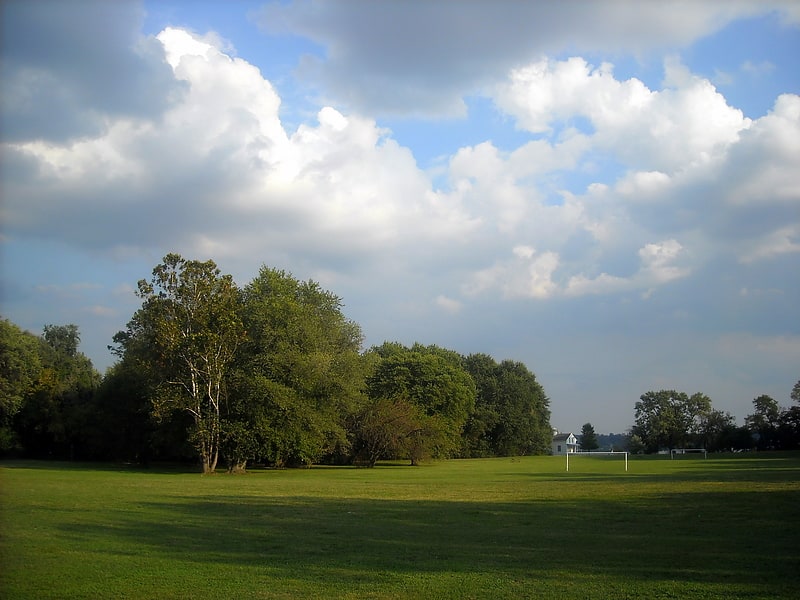
Park in Alexandria, Virginia. Jones Point is a geographic point on the Potomac River within the city of Alexandria, Virginia, United States. The Jones Point Light and Jones Point Park are located at the point, which is immediately North of the confluence of Hunting Creek and the Potomac River. The 1791-1792 survey of the original boundaries of the District of Columbia began at a spot that was then at the tip of a cape at the Point. The south cornerstone from the boundary survey remains in a seawall several yards south of the lighthouse.
The Woodrow Wilson Bridge crosses the park, most of which is under the jurisdiction of the National Park Service. The Mount Vernon Trail travels through the park.
Jones Point underwent a major renovation, completed in 2012, which included National Park Service placards along walking and biking trails highlighting its history. Other improvements include larger parking lots, a basketball court, a playground, a concession stand, restrooms, new walking and bike paths, small fishing/sightseeing piers, and easy access to the Jones Point lighthouse. The National Park Service and others have erected in and near the park a number of markers that relate the history of Jones Point and its surroundings.[14]
Address: Jones Point Park, 22314 Alexandria (Alexandria)
Athenaeum
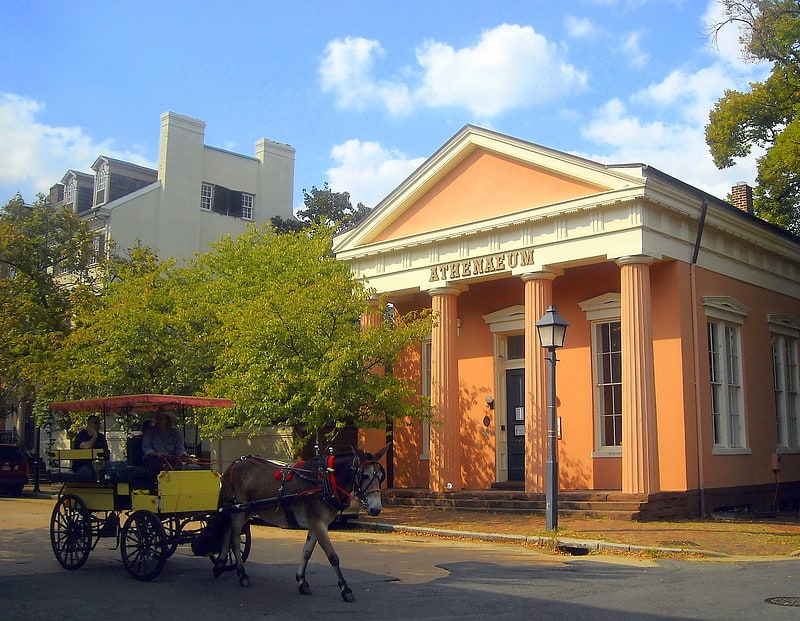
Art gallery in Alexandria, Virginia. The Athenaeum is a gallery of fine arts and a performance venue in Alexandria, Virginia, United States. It is also home to the Northern Virginia Fine Arts Association since 1964. The building is an important example of Greek Revival architecture. The Athenaeum has a long history and has served several purposes during its lifetime. The building is now part of the Virginia Trust and was listed on the National Register of Historic Places in 1980.[15]
Address: 201 Prince St, 22314-3384 Alexandria (Alexandria)
St. Paul's Episcopal Church

Episcopal church in Alexandria, Virginia. St. Paul's Episcopal Church is an historic Episcopal church in the Anglican Communion located in the Old Town area of Alexandria, Virginia. The church, consecrated in 1818, was designed by Benjamin Latrobe, the second architect of the United States Capitol. It is one of the few buildings designed by Latrobe in a Gothic style and one of the earliest examples of Gothic Revival architecture in the United States. The church was placed on the National Register of Historic Places in 1985. During the year 2009, St. Paul's Episcopal Church celebrated the bicentennial of its founding.[16]
Address: 228 S Pitt St, 22314-3797 Alexandria (Alexandria)
Oxon Hill Manor

Event venue in Fort Washington, Maryland. Oxon Hill Manor is a neo-Georgian house of 49 rooms, located at Forest Heights, Prince George's County, Maryland. It was designed in 1928 for Sumner Welles by the Washington architect, Jules Henri de Sibour. It was built in 1929, and consists of a two-story main block of Flemish bond brick and a northern wing. Also on the property are two outbuildings contemporary with the house; a five-car garage and attached manager's quarters and greenhouse, and a stable. There are also formal gardens on the grounds.[17]
Address: 6901 Oxon Hill Rd, 20745-1549 Oxon Hill
Cameron Run Regional Park
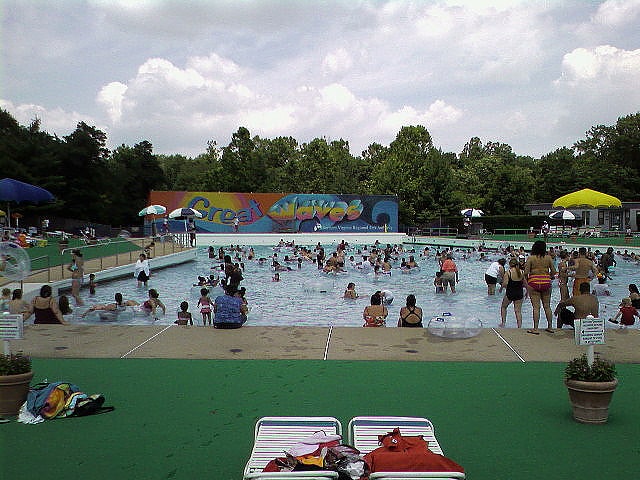
Amusement park in Alexandria, Virginia. Cameron Run Regional Park is a regional park located on Eisenhower Avenue, near Cameron Run, in Alexandria, northern Virginia.
It is protected and operated by the NOVA Parks agency of Northern Virginia, formerly the Northern Virginia Regional Park Authority.[18]
Address: 4001 Eisenhower Ave, 22304-6441 Alexandria (Alexandria)
River Farm
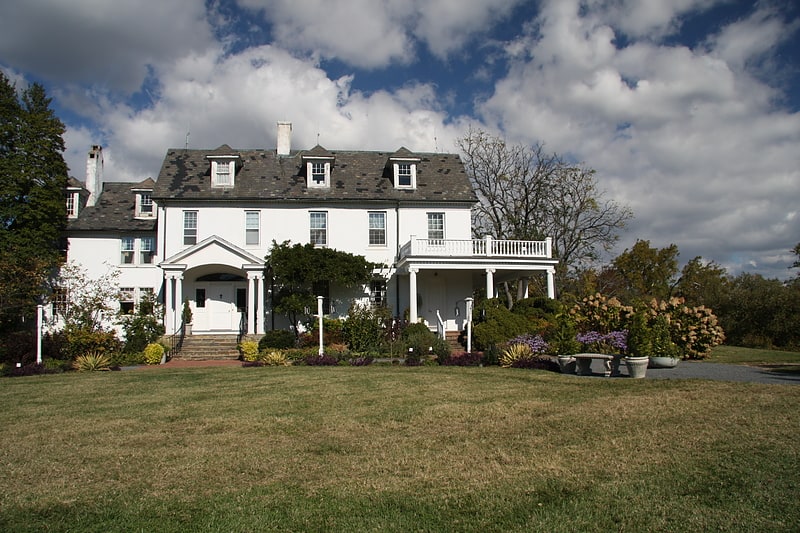
Tourist attraction in the Fort Hunt, Virginia. River Farm, currently home to the American Horticultural Society headquarters, is a landscape located at 7931 East Boulevard Drive, Alexandria, Virginia. The estate takes its name from a larger plot of land which formed an outlying part of George Washington's Mount Vernon estate.[19]
Address: 7931 E Boulevard Dr, 22308-1307 Alexandria
National Inventors Hall of Fame
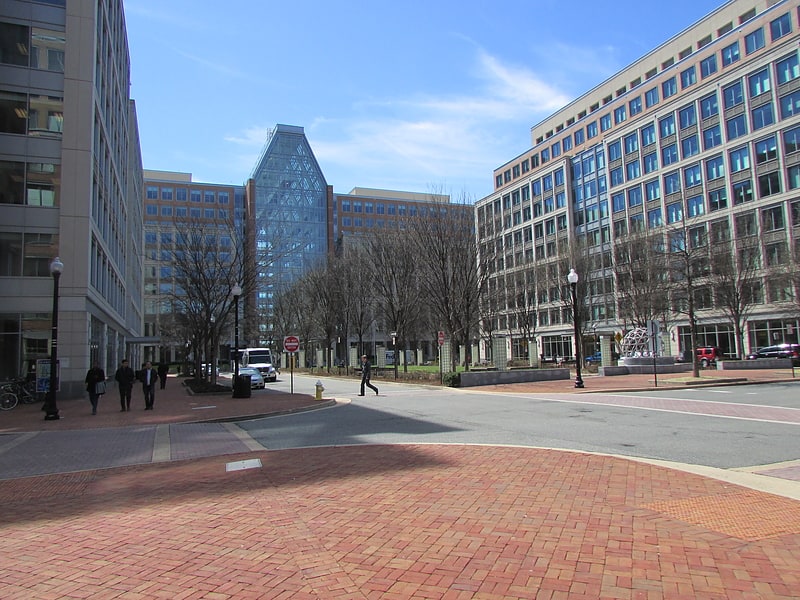
The National Inventors Hall of Fame is an American not-for-profit organization, founded in 1973, which recognizes individual engineers and inventors who hold a U.S. patent of significant technology. Besides the Hall of Fame, it also operates a museum in Alexandria, Virginia, sponsors educational programs, and a collegiate competition.
As of 2020, 603 inventors have been inducted, mostly constituting historic persons from the past three centuries, but including about 100 living inductees. Nominees must hold a U.S. patent of significant contribution to the U.S. welfare, and which advances science and useful arts. The 2020 class included 22 inventors.[20]
Address: 600 Dulany St, 22314 Alexandria (Alexandria)
Old Presbyterian Meeting House
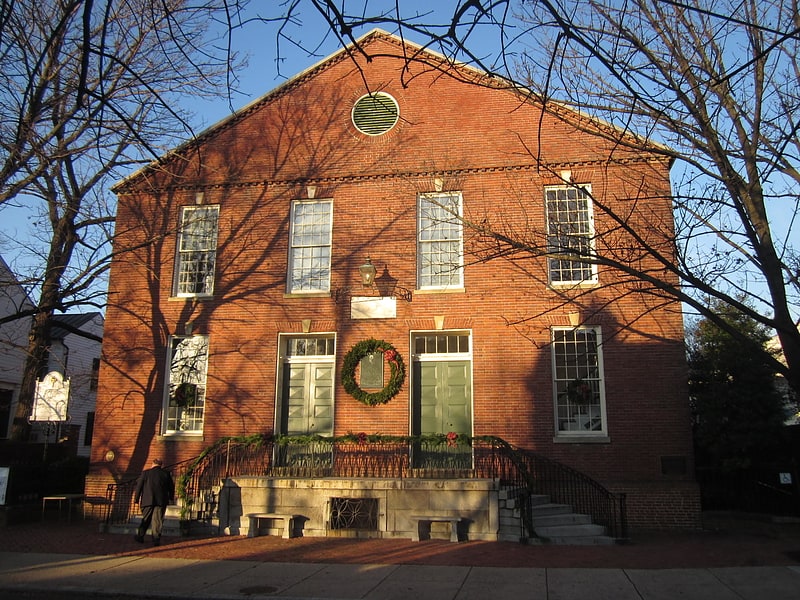
Presbyterian church in Alexandria, Virginia. The Old Presbyterian Meeting House is a Christian church located at located at 321 South Fairfax Street in the Old Town neighborhood of Alexandria, Virginia. It is part of the National Capital Presbytery and the Synod of the Mid-Atlantic of the Presbyterian Church.
The meeting house was originally built in 1775 in the Early Republic style, but was largely destroyed by fire in 1835. It was rebuilt in 1836, and a bell tower was added in 1843 and granite entrance stairs were installed in 1853. The campus was added to the National Register of Historic Places in 2001. The church also lies within the bounds of the Alexandria Historic District.[21]
Address: 321 S Fairfax St, 22314 Alexandria (Alexandria)
Washington and Old Dominion Railroad Regional Park
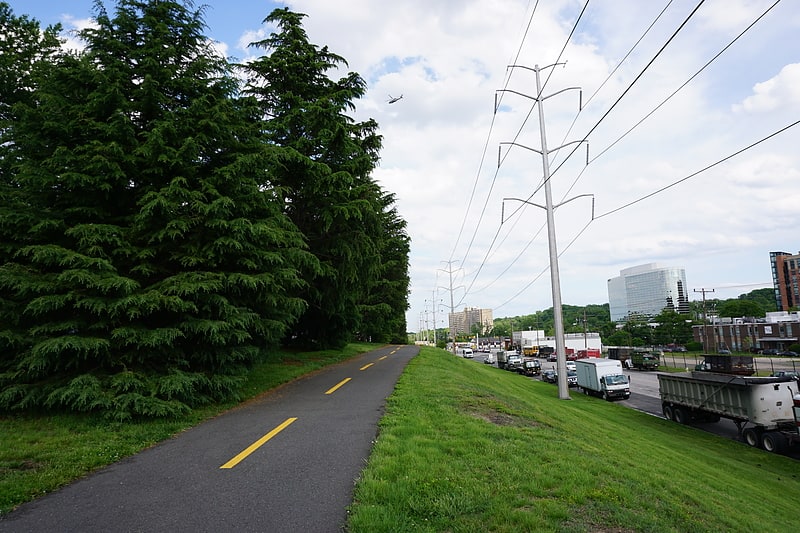
Regional park in Arlington, Virginia. The Washington and Old Dominion Railroad Regional Park is a linear regional park in Northern Virginia. The park's primary feature is the Washington and Old Dominion Railroad Trail, an asphalt-surfaced paved rail trail that runs through densely populated urban and suburban communities as well as through rural areas. Most of the trail travels on top of the rail bed of the former Washington and Old Dominion Railroad, which closed in 1968.
Although the park is 44.6 miles (71.8 km) long, it is only about 100 feet (30 m) wide. The rail trail is approximately 10 feet (3.0 m) wide through much of its length and is a shared use path that is suitable for walking, running, cycling, and roller skating.
A crushed bluestone–surfaced bridle path travels near the paved trail in the park's most westerly 33 miles (53 km). The path is suitable for horseback riding and mountain biking.
NOVA Parks (formerly named the Northern Virginia Regional Park Authority (NVRPA)) administers and maintains the park and its trails. NOVA Parks keeps most of the parkland surrounding the trails in a natural state. The park authority has placed alongside the paved trail a series of mile markers and a number of interpretative exhibits that describe the historic and natural features of the park (see Washington and Old Dominion Railroad Stations for locations of historical markers near the W&OD Trail).
The headquarters office of the park is near the southwest side of the trail at Smith's Switch Road in Ashburn. A park rest stop is adjacent to the trail near the park's headquarters.[22]
Alfred Street Baptist Church
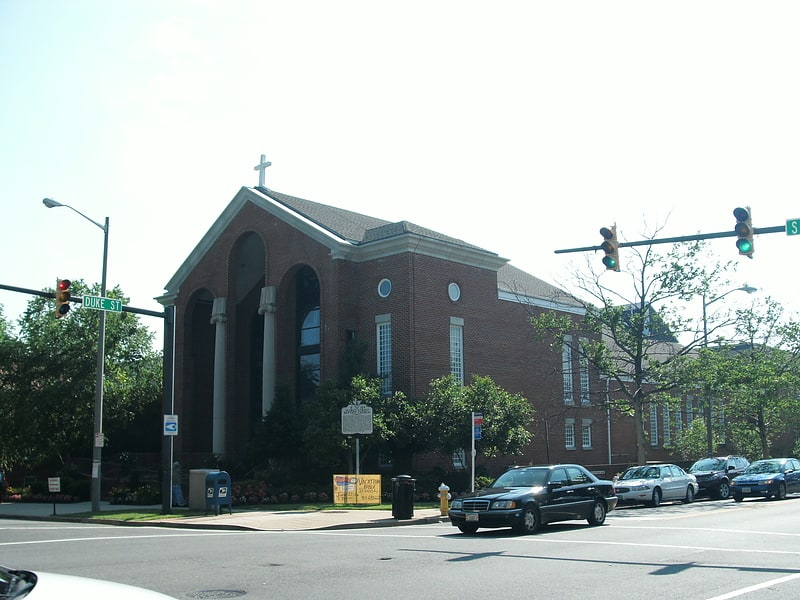
Baptist church in Alexandria, Virginia. Alfred Street Baptist Church's is a Baptist church in Alexandria, Virginia, United States, affiliated with the National Baptist Convention, USA.[23]
Address: 301 S Alfred St, 22314-3670 Alexandria (Alexandria)
Appomattox Statue
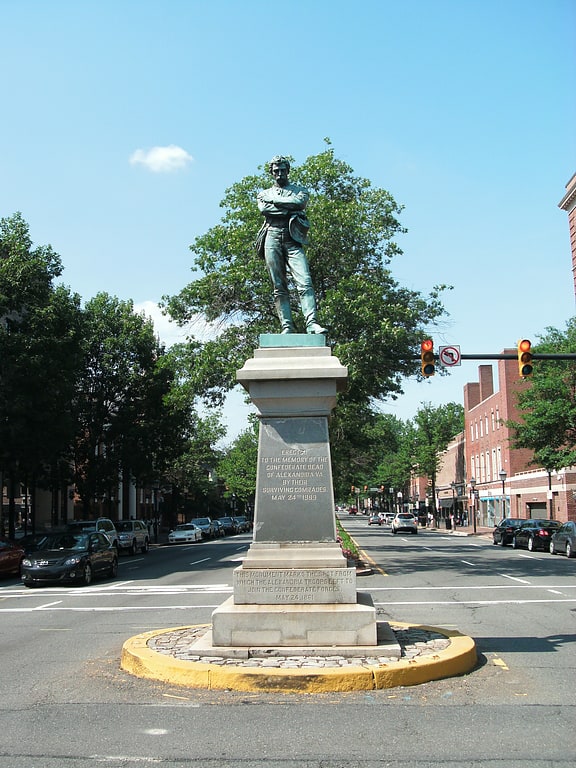
Statue by Caspar Buberl. Appomattox is a bronze statue commemorating soldiers from Alexandria, Virginia, who had died while fighting for the Confederacy during the American Civil War. The memorial was located in the center of the intersection of South Washington Street and Prince Street in the Old Town neighborhood of Alexandria.
The National Park Service placed the monument on the National Register of Historic Places during 2017. The statue was removed on June 2, 2020, during nationwide protests during which vandals defaced segregation-era statues following the May 2020 murder of George Floyd in Minneapolis, Minnesota.[24]
Address: S. Washington St., 22314 Alexandria (Alexandria)
Huntington station
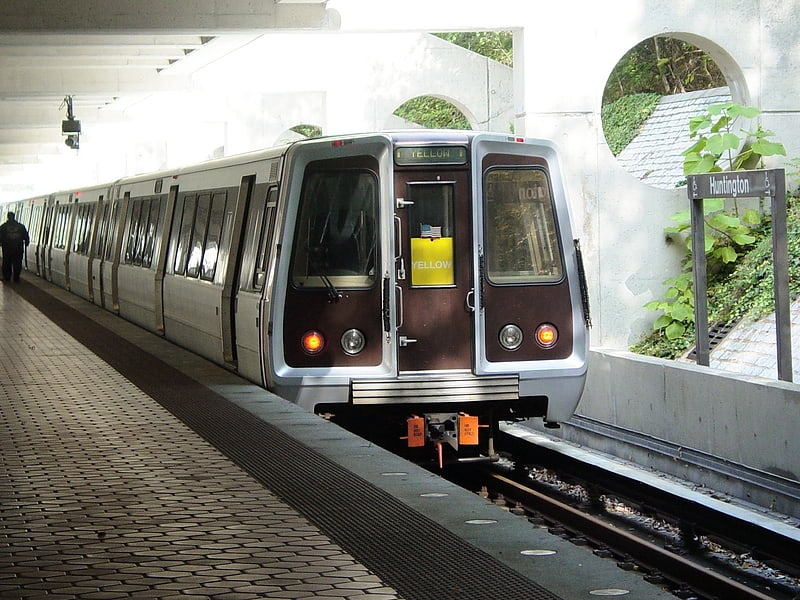
Huntington is an island-platformed Washington Metro station in the Huntington area of Fairfax County, Virginia, United States. The station was opened on December 17, 1983, and is operated by the Washington Metropolitan Area Transit Authority. Serving as the southern terminus for the Yellow Line, the station is built into a hillside; the south mezzanine, along with escalator access, is accessible via an incline elevator.
The station serves the suburban area of Fairfax County and is a popular commuter station with over 3,000 parking spaces. It is located between North Kings Highway (State Route 241) and Huntington Avenue, with parking facilities and station entrances available off of both roads. Service began on December 17, 1983, making it the first station to open in Fairfax County, and the first to extend the system beyond the Capital Beltway. The station is located on the ruins of Fort Lyon, a Civil War-era fort.[25]
St. Mary Catholic Church
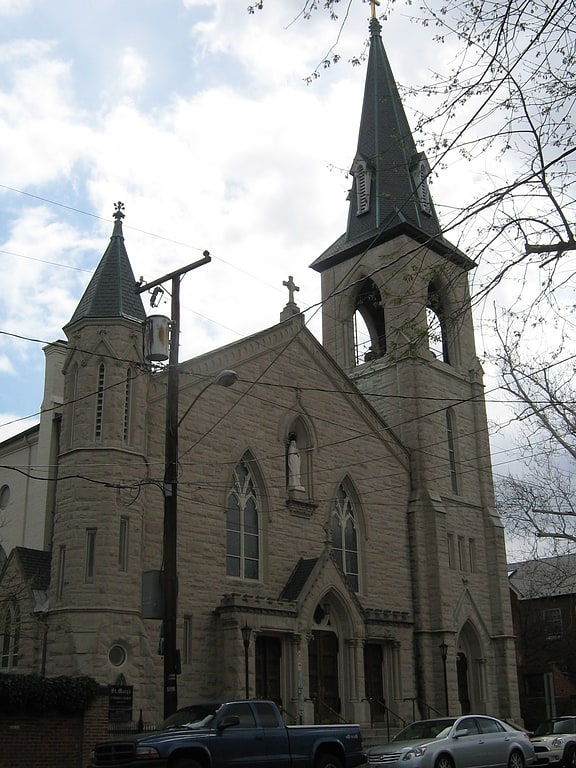
Basilica in Alexandria, Virginia. The Basilica of Saint Mary in the Old Town historic district, of Alexandria, Virginia, and is a minor basilica and parish church of the Roman Catholic Diocese of Arlington in Virginia. St. Mary's Basilica is the oldest Roman Catholic church in the Commonwealth of Virginia. It was founded in 1795 by the Very Reverend Francis Ignatius Neale, S.J. then President of Georgetown University, in present-day western Washington, D.C.
On December 6, 2017, Pope Francis designated the parish church as a minor basilica. The decision was announced on January 15, 2018, and the basilica held its inauguration Mass on September 8, 2018.[26]
Address: 310 S Royal St, 22314 Alexandria (Alexandria)
Lyceum
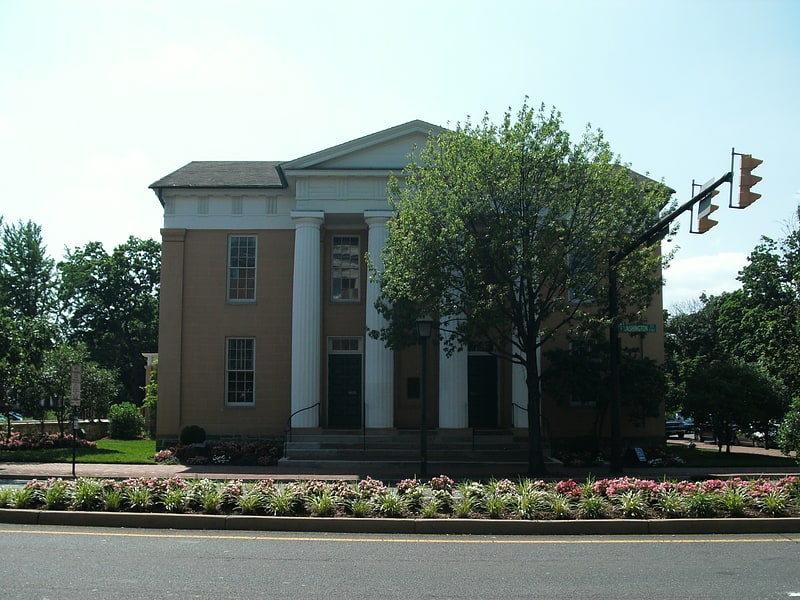
Museum in Alexandria, Virginia. The Lyceum is a historic structure in Alexandria, Virginia. It was built in 1839 and has been listed on the National Register of Historic Places since May 27, 1969. It was built, from bricks from the original St. Mary chapel, as a permanent home for the Alexandria Lyceum and the Alexandria Library. It served as a hospital during the American Civil War. After the war it became a private home and later served as an office building. Today it is the location of the official city history museum of Alexandria.[27]
Address: 201 S Washington St, 22314-3625 Alexandria (Alexandria)
Stabler-Leadbeater Apothecary Shop
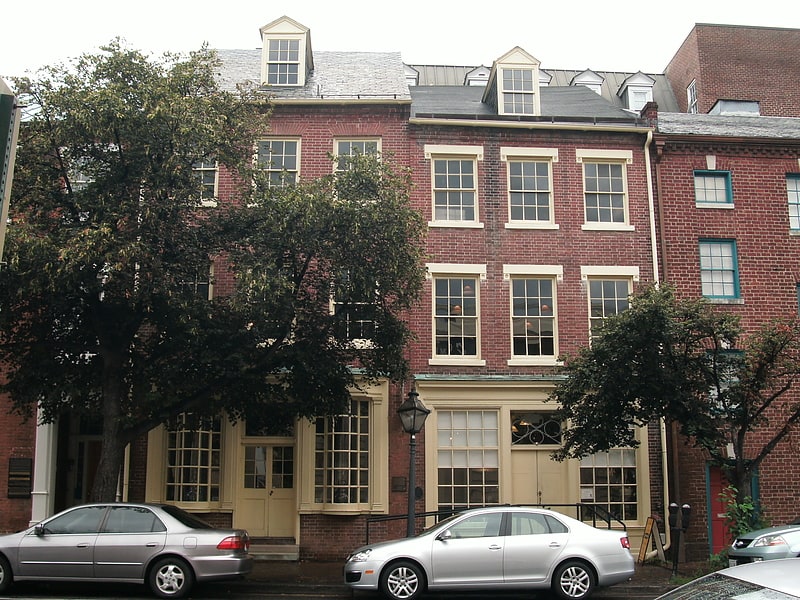
Museum in Alexandria, Virginia. The Stabler-Leadbeater Apothecary Shop/Museum is a historic apothecary's shop in Alexandria, Virginia, that has been preserved as a museum. During its working life, it was owned by generations of a Quaker family. Eventually, a dramatic decline in sales during the Great Depression forced the shop to close its doors. Almost immediately, in 1939, it was reopened as a museum. Today, most of the artifacts inside the shop are authentic and date to its closing. The building was added to the National Register of Historic Places in 1982, and designated a National Historic Landmark in 2021.[28]
Address: 105 S. Fairfax St, Alexandria (Alexandria)
Contrabands and Freedmen Cemetery
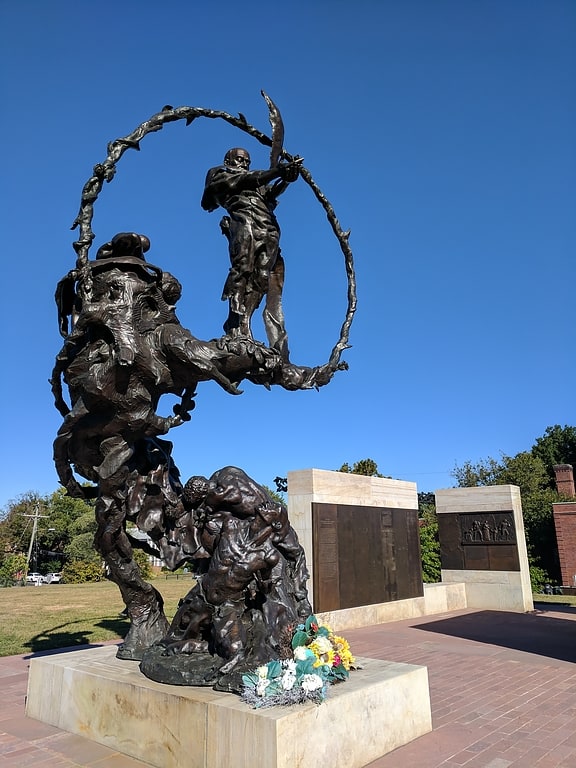
Cemetery in Alexandria, Virginia. The Contrabands and Freedmen Cemetery at 1001 S. Washington St. in Alexandria, Virginia was listed on the National Register of Historic Places on August 15, 2012. It was established in February 1864 by the Union military commander of the Alexandria District for use as a cemetery for the burial of African Americans who had escaped slavery, known as contrabands and freedmen. During early Reconstruction, it was operated by the Freedmen's Bureau. It was closed in late 1868, after Congress ended most operations of the Bureau. The last recorded burial was made in January 1869.
The history of the site was rediscovered in the late 20th century, and archeological techniques were used to identify its boundaries and burials. The land was acquired by the city and the cemetery re-established as a memorial in 2014.
Initially the Union Army buried soldiers of the United States Colored Troops here as well. But African American troops in Alexandria's hospitals "demanded that blacks be given the honor of burial in the Soldiers' Cemetery, now Alexandria National Cemetery." In January 1865, the soldiers' remains were moved to the military cemetery.[29]
Address: 638 N Alfred St, Alexandria (Alexandria)
Virginia Theological Seminary

Seminary in Alexandria, Virginia. Virginia Theological Seminary, formally called the Protestant Episcopal Theological Seminary in Virginia, located at 3737 Senminary Road in Alexandria, Virginia is the largest and second oldest accredited Episcopal seminary in the United States.
Established in 1823, VTS is situated on an 80-acre (320,000 m2) suburban campus in Alexandria, Virginia, close to downtown Washington, DC and adjacent to the campus of Episcopal High School. The seminary's notable alumni have taken leadership roles in the Episcopal Church, other Christian denominations in the United States, and overseas.
VTS is a member of the Washington Theological Consortium and since 1938 has been an accredited member institution of the Association of Theological Schools in the United States and Canada (ATS).[30]
Alexandria National Cemetery

Cemetery. Alexandria National Cemetery is a United States National Cemetery, of approximately 5.5 acres, located in the city of Alexandria, Virginia. Administered by the United States Department of Veterans Affairs, it is one of the original national cemeteries that were established in 1862. As of 2014, it was site to over 4,500 interments. The cemetery can accommodate the cremated remains of eligible individuals.[31]
Address: 1450 Wilkes St, 22314-3424 Alexandria (Alexandria)
Lloyd House
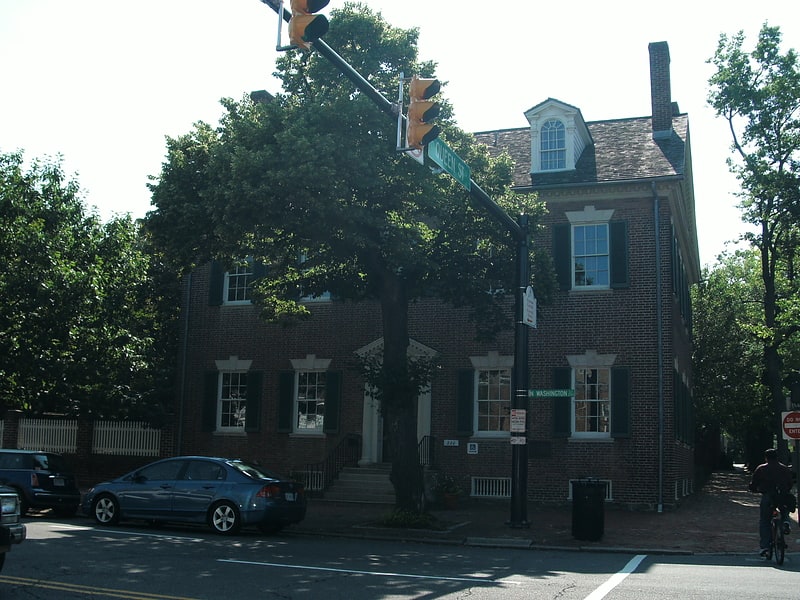
City government office in Alexandria, Virginia. The Lloyd House, also known as the Wise-Hooe-Lloyd House, is a historic house and library located at 220 North Washington Street at the corner of Queen Street in the Old Town area of Alexandria, Virginia. It was built from 1796 to 1797 by John Wise, a prominent entrepreneur, in the late eighteenth-century Georgian architectural style. The house was added to the National Register of Historic Places on July 12, 1976.[32]
Address: 220 N Washington St, Alexandria (Alexandria)
The Little Theatre of Alexandria

Theatre in Alexandria, Virginia. The Little Theatre of Alexandria is a community theatre located at 600 Wolfe Street in Alexandria, Virginia. It was founded by Mary Lindsey in 1934 and was originally known as the Peacock Players. It has since staged more than 350 productions. During recent years it has produced a seven to ten show season. and is particularly well known for its one-act playwriting competition. It has played an important role in launching the careers of playwrights such as Sandra Fenichel Asher, Rich Orloff, and Jacob M. Appel.
The theatre has a member/subscriber base of over 2000 and owns its own building, which was completed in 1961..[33]
Address: 600 Wolfe St, 22314-3732 Alexandria (Alexandria)
Oxon Cove Park and Oxon Hill Farm
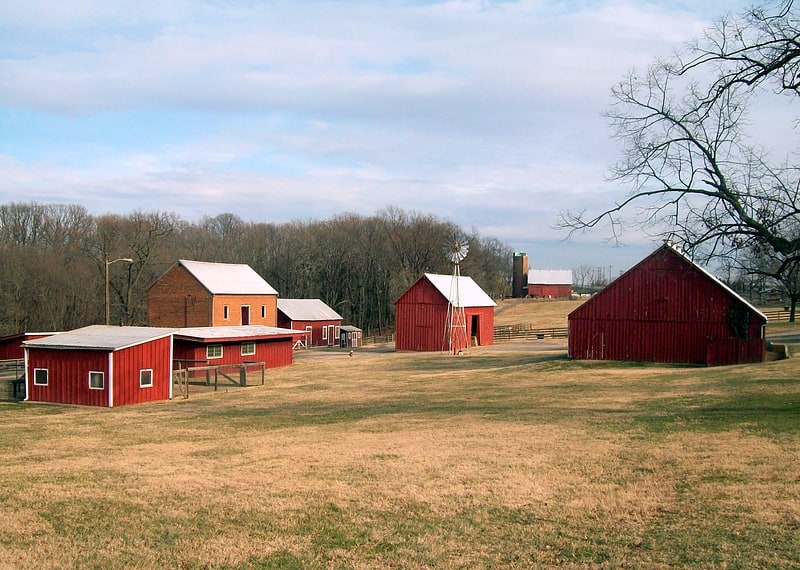
National park in Prince George's County, Maryland. Oxon Cove Park and Oxon Cove Farm is a national historic district that includes a living farm museum operated by the National Park Service, and located at Oxon Hill, Prince George's County, Maryland. It is part of National Capital Parks-East. It was listed on the National Register of Historic Places in 2003.
The park provides an excellent resource for environmental studies, wildlife observing, fishing, and other recreational activities made possible by easy access to the Potomac River. Fourteen buildings and two structures are located in the historic district and associated with the property's sequential development as a plantation, an institutional agricultural complex, and a farm museum.[34]